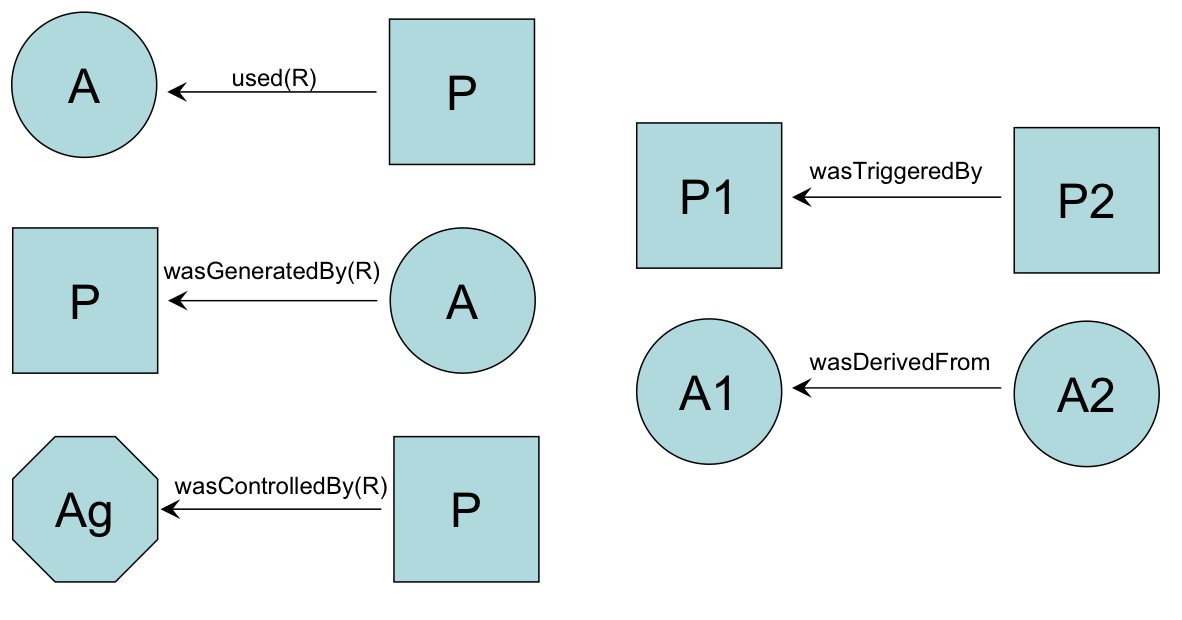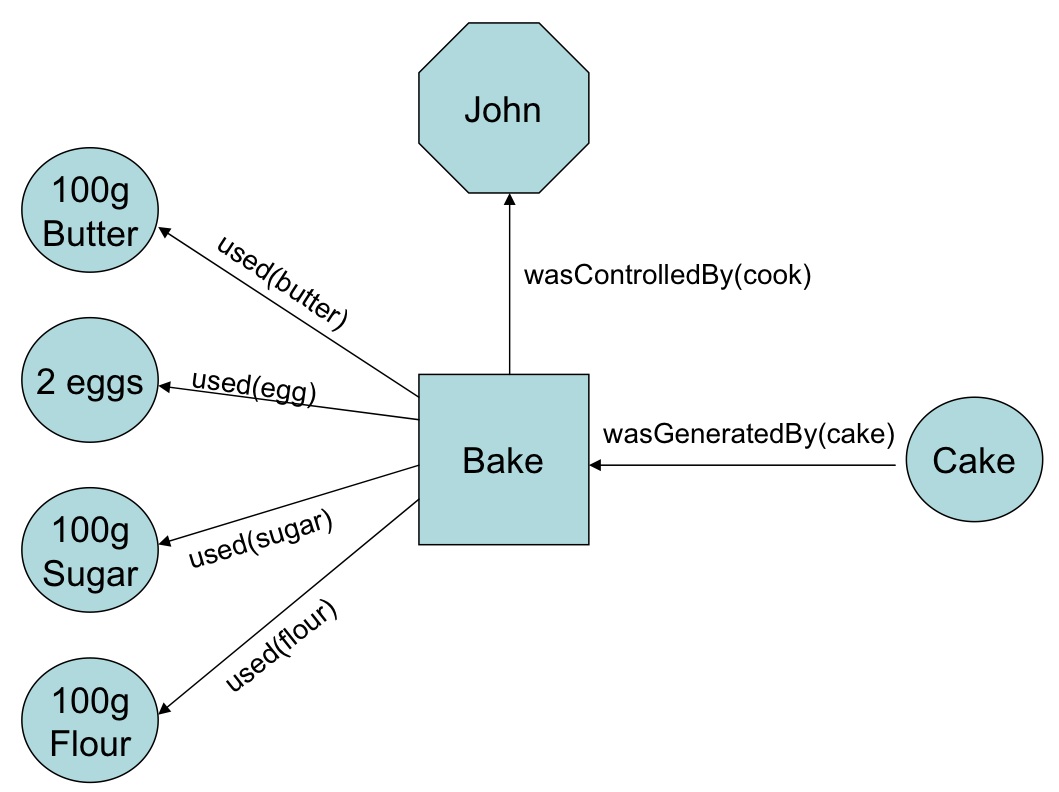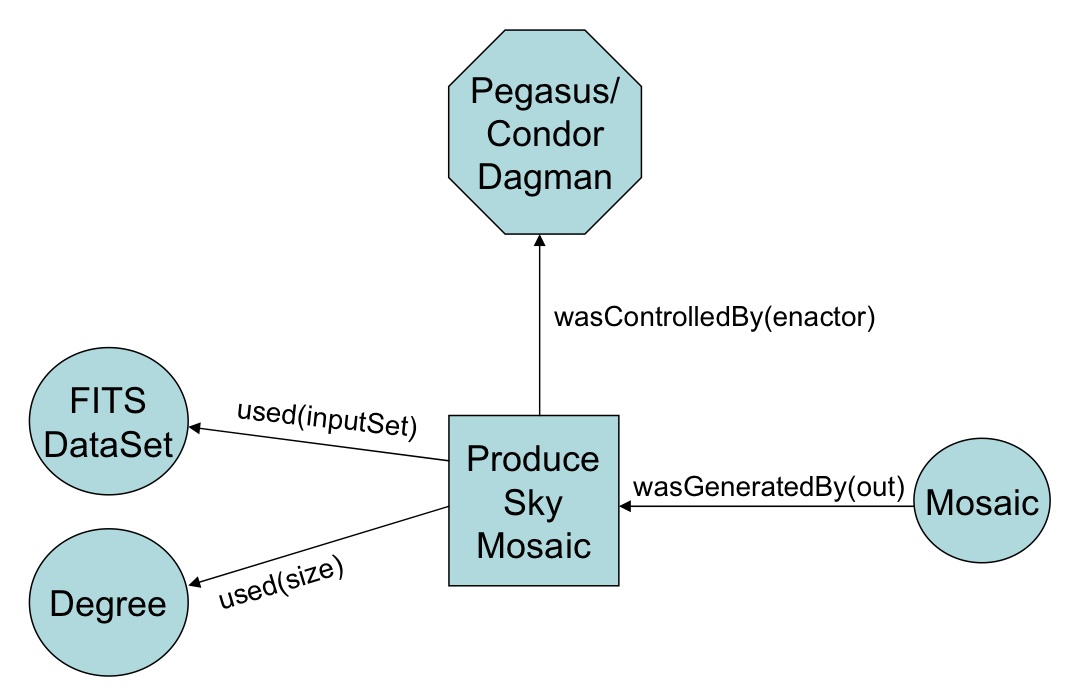Start of topic | Skip to actions
Open Provenance Model Contents
to top
- Introduction
- Basics
- Overlapping and Hierarchichal Descriptions
- Provenance Graph Definition
- Timeless Formal Model
- Inferences
- Formal Model and Time Annotations
- Time Constraints and Inferences
- Support for Collections
- Example of Representation
- Conclusion
- Best Practice on the Use of Agensts
- References
2 Basics
2.1 Entities
Our primary concern is to be able to represent how "things", whether digital data such as simulation results, physical objects such as cars, or immaterial entities such as decisions, came out to be in a given state, with a given set of characteristics, at a given moment. It is recognised that many of such "things" can be stateful: a car may be at various locations, it can contain different passengers, and it can have a tank full or empty; likewise, a file can contain different data at different moments of its existence. Hence, from the perspective of provenance, we introduce the concept of an artifact as an immutable1 piece of state; likewise, we introduce the concept of a process as actions resulting in new artifacts. A process usually takes place in some context, which enables or facilitates its execution: examples of such contexts are varied and include a place where the process executes, an individual controlling the process, or an institution sponsoring the process. These entities are being referred to as Agents. Agents, as we shall see when we discuss causality dependencies, are a cause (like a catalyst) of a process taking place. The Open Provenance Model is based on these three primary entities, which we define now. Definition 1 (Artifact) Immutable piece of state, which may have a physical embodiment in a physical object, or a digital representation in a computer system. Definition 2 (Process) Action or series of actions performed on or caused by artifacts, and resulting in new artifacts. Definition 3 (Agent) Contextual entity acting as a catalyst of a process, enabling, facilitating, controlling, affecting its execution. The Open Provenance Model is a model of artifacts in the past, explaining how they were derived. Likewise, as far as processes are concerned, they may also be in the past, i.e. they may have already completed their execution; in addition, processes can still be currently running (i.e., they have not completed their execution yet). In no case is OPM intended to describe the state of future artifacts and the activities of future processes. We introduce a graphical notation and a formal definition for provenance graphs. Specifically, artifacts are represented by circles, and are denoted by elements of the set Artifact. Likewise, processes are represented graphically by rectangles and denoted by elements of the set Process. Finally, agents are represented by octogons and are elements of the set Agent in the formal notation. Footnote 1: In the presence of streams, we consider an artifact to be a slice of stream in time, i.e. the stream content at a specific instant in the computation. A future version of OPM will refine the model to accomodate streams fully as they are recognized to be crucial in many applications. piece of state; likewise, we introduce the concept of a process as actions resulting in new artifacts.2.2 Dependencies
A provenance graph aims to capture the causal dependencies between the abovementioned entities. Therefore, a provenance graph is defined as a directed graph, whose nodes are artifacts, processes and agents, and whose edges belong to one of following categories depicted in Figure 1. An edge represents a causal dependency, between its source, denoting the effect, and its destination, denoting the cause.

Figure 1: Edges in the Provenance Model
- Expressibility. It is anticipated that systems will produce descriptions of what their components are doing, without having intimate knowledge of the exact internal data and control dependencies. Weak notions of dependency are necessary for such systems to be able to use OPM in practice.
- Composability. We shall see how OPM supports multi-level descriptions (Section~\reoverlapping:descriptio). In a system consisting of the parallel composition of two subcomponents, the high level summary of the system requires a weaker notion of dependency than the low level descriptions of its subcomponents. Hence, we adopt the following causal dependencies in OPM. We anticipate that subclasses of these dependencies, capturing stronger notions of causality, may be defined in specific systems, and over time, may be incorporated in OPM.
2.3 Roles
A role is an annotation on used, wasGeneratedBy and wasControlledBy. Defintion 10 (Role) A role designates an artifact's or agent's function in a process. A role is used to differentiate among several use, generation, or controlling relations.- A process may use (generate) more than one artifact. Each used (wasGeneratedBy) relation may be distinguished by a role with respect to that process. For example, a process may use several files, reading parameters from one, and reading data from another. The used relations would be labeled with distinct roles.
- An artifact might be used by more than one process, possibly for different purposes. In this case, the used relations can be distinguished or said to be the same by the roles associated with the used relations. For example, a dictionary might be used by one process to look up the spelling of "provenance", (role = "look up provenance"), while another process uses the same dictionary to hold open the door ( role = "doorstop").
- An agent may control more than one process. In this case, the different processes may be distinguished by the role associated with the wasControlledBy relation. For example, a gardener may control the digging process (role = "dig the bed"), as well as planting a rose bush (role = "plant") and watering the bush (role = "irrigating")
- A process may be controlled by more than one agent. In this case, each agent might have a distinct control function, which would be distinguished by roles associated with the wasControlledBy relations. For example, boarding the train may be controlled by the ticket agent (role = "sell ticket"), the gate agent (role = "take ticket") and the steward (role = ``guide to seat'').
2.4 Examples
An example illustrating all the concepts and a few of the causal dependencies is displayed in Figure 2. This provenance graph expresses that John baked a cake with ingredients butter, eggs, sugar and flour.

Figure 2: Victoria Sponge Cake Provenance

Figure 3: Montage Provenance
Comments
I don't see the advantage to incorportating streams -- they caused a lot of problems when we came up with the initial model (patrick.paulson@pnl.gov) -- PatrickPaulson - 18 Aug 2008to top
| I | Attachment  | Action | Size | Date | Who | Comment |
|---|---|---|---|---|---|---|
| | edges2.jpg | manage | 73.0 K | 30 Jul 2008 - 19:17 | PaulGroth | |
| | cake2.jpg | manage | 93.8 K | 30 Jul 2008 - 18:46 | PaulGroth | |
| | pegasus1.jpg | manage | 80.9 K | 30 Jul 2008 - 18:48 | PaulGroth |